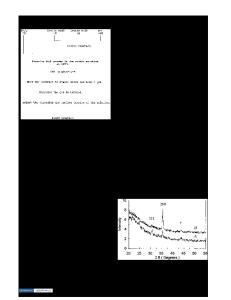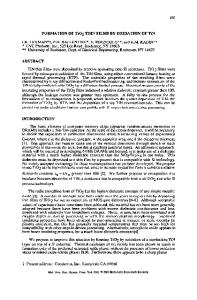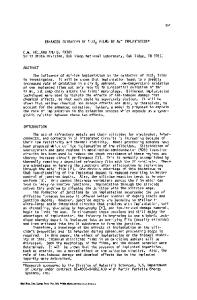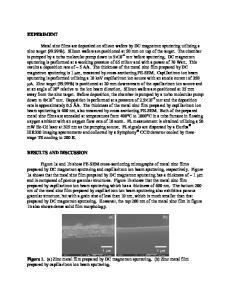Fabrication of EuO films by oxidation of Eu metal films
- PDF / 466,456 Bytes
- 5 Pages / 576 x 792 pts Page_size
- 68 Downloads / 341 Views
Ferromagnetic europium (EuO) films have been made by oxidizing europium (Eu) metal films deposited on glass substrates using a thermal evaporation technique. It has been found that the quality of the films is sensitive to substrate temperature. Stable EuO films were formed only if Eu metal films were annealed at temperatures of 320 to 380 °C. Both x-ray diffraction pattern (XRD) and magnetization measurements indicate that a significant amount of EuO phase has been formed in the films. These films undergo a phase transition from paramagnetic to ferromagnetic phase at temperatures between 60 and 70 K and exhibit the magneto-optical Faraday effect. The saturation magnetic moment at 10 K is about 40% of the theoretical value, and the coercive force, Hc, for slow sweeping field is about 70 Oe.
I. INTRODUCTION Nondestructive measurement of the critical current density in superconducting thin films with structures as small as 10 /xm is desired to monitor the fabrication of superconducting devices. Magneto-optical glasses, which were first used by Alers1 and DeSorbo2 to image magnetic flux in superconductors, have been successfully used in studies of critical currents or flux distribution in high-temperature superconductors.3'4 The best spatial resolution is only about 0.1 mm for a magneto-optical glass of 1.0 mm thickness. Further improvements of the resolution requires reduction of the glass thickness. This would result in reduction of the Faraday rotation and difficulties in sample handling. To have a spatial resolution of 10 /j,m or better, magneto-optical thin films should be used. It has been reported that a spatial resolution of 1 fim is possible using a thin-film EuS/EuF 2 mixture.5"7 However, the Curie temperature of the mixture is low so that liquid helium is needed. Iron garnet films have been used for studies of high-temperature superconductors at higher temperatures,8'9 but the magnetic field strength is inferred from the spacing of antiferromagnetic domains so that direct imaging is not possible. Furthermore, the requirement for special substrates for good films makes it very difficult to deposit these films on superconductors. Because of its high Curie temperature (69 K), which is comparable with the working temperature for the high Tc superconductors, and large Faraday rotation, thin-film europium oxide (EuO) is a good candidate for measurements of critical current in high-temperature superconducting films at liquid nitrogen temperatures (64-77 K) with micrometer resolution. Because Eu ions can exist in two valence states, Eu++ and Eu3+, two europium oxide compounds, EuO and Eu 2 O 3 , are possible. Eu 2 O 3 is antiferromagnetic and is a more stable compound than ferromagnetic EuO. In the 462 http://journals.cambridge.org
J. Mater. Res., Vol. 8, No. 3, Mar 1993 Downloaded: 13 Mar 2015
oxidation of Eu, the more stable Eu 2 O 3 is energetically favored to form unless special care is taken. Thin-film EuO can be made either by direct evaporation of a bulk EuO source or by co-evaporation of Eu 2 O 3 and Eu m
Data Loading...










